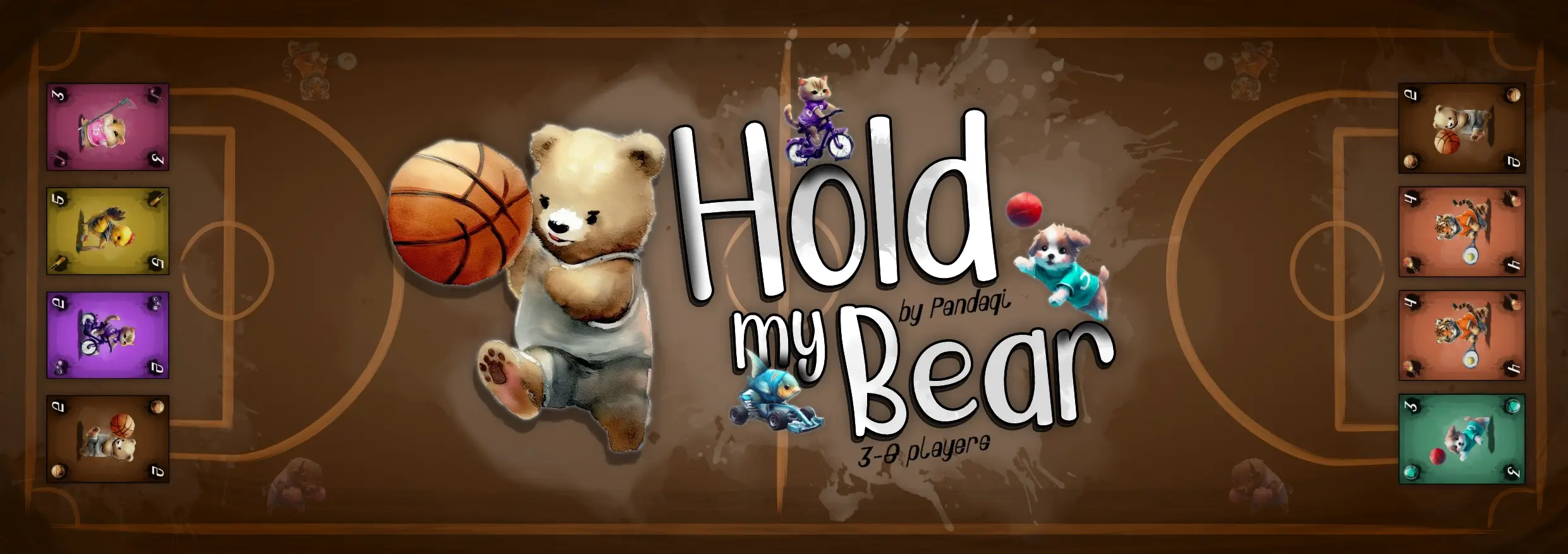Draw a random card and place it face-up on the table. This is the “match” currently taking place.
Deal the deck of cards until empty, as fairly as possible.
The player with the highest bear card starts.
You win if, at the start of your turn, the match on the table is already yours! (You played a match that nobody could defeat for a whole round.)
Take clockwise turns until done. On your turn, do ONE of two things: play a valid move or give away two cards.
If you’re out of cards (at the start of your turn), steal 4 cards from other players, in whatever way you want.
Cards have an animal and a number.
A “match” is simply the set of cards in the center of the table.
- The sport you’re playing is determined by the majority animal: the animal that appears most often. (If tied, you play multiple sports at once!)
- How well you’re doing is determined by the sum of all numbers.
To do a valid move, you must play a set of cards that …
- Changes the sport. Provide another animal that occurs more often than the current majority animal. The total value doesn’t matter.
- Or plays the same sport, but better. Play cards with the same majority animal, but with a total value that’s higher.
Remove the previous match (cards) from the game. Ensure the new cards face you to remember you were the one who played them!

Give away two hand cards. (To the same player or two different players.) This happens publicly: everyone can see the cards.
Bears are both a trump and a wildcard. What does that mean?
- You can always raise the match by simply playing more bears. (Example: 2 tigers can be trumped by 1 bear, as that is more than 0 bears.)
- On their own, bears are any type you want. When played in combination, they become the majority animal(s). (Example: you play 2 tigers and 2 bears. Now there are 4 tigers on the table.)
Bears are, however, also a liability.
- You cannot win with a bear in your hand. (If you do, replace the current match with that bear. The first player after you who CAN play a valid move MUST do so now.)
- You also cannot play non-bear cards that have the same number as a bear in your hand. (Not even if you play the bear as well in the same match!)

Played a few games and ready for a bigger challenge? Try the expansion(s)!
This game has 14 “expansion animals”. You can swap regular animals for expansion animals however you like, as long as every game has the bear in it!
These animals have a simple action. There are three types.
- ALWAYS: These are always active.
- WHEN PLAYED: These trigger when you play the card as part of a match.
- WHEN GIVEN: These trigger when you give away this card (as part of the “give away” action on your turn).
You can only do a specific animal’s action once per turn. If you played 3 Aardvarks, for example, you only do their action once.
The actions are explained on the cards themselves. Below are just some clarifications in case you’re uncertain.
- Turtle: “another card” means you can’t give back a turtle with the same number, but any other card is fine.
- Ape: “other animals” means other animal types. In other words, you can never play a match that’s only apes.
- Walrus: simply the opposite of Ape. You can never play a match with a Walrus and some other animal(s).
- Bat: remember that “multiple sports” means there are multiple animals that have the majority. So a match of “Bat + Tiger” is forbidden, as both appear once and thus are both the majority animal.
- Squid: simply the opposite of Bat. A match of “Squid + Tiger” is allowed. But “Squid + Squid + Tiger” isn’t, as that match plays only one sport (skiing).
- Rabbit: remember that this stays true as long as the card shows. If (on your turn) there’s a match with a rabbit on the table, and you can do a valid move, you must do so.
- Sheep: surprisingly powerful. “Tie” refers to all rules, so you may tie bears, tie majority animal, and tie number. If the current match has a sheep, there are many more ways to play a valid move over it.
